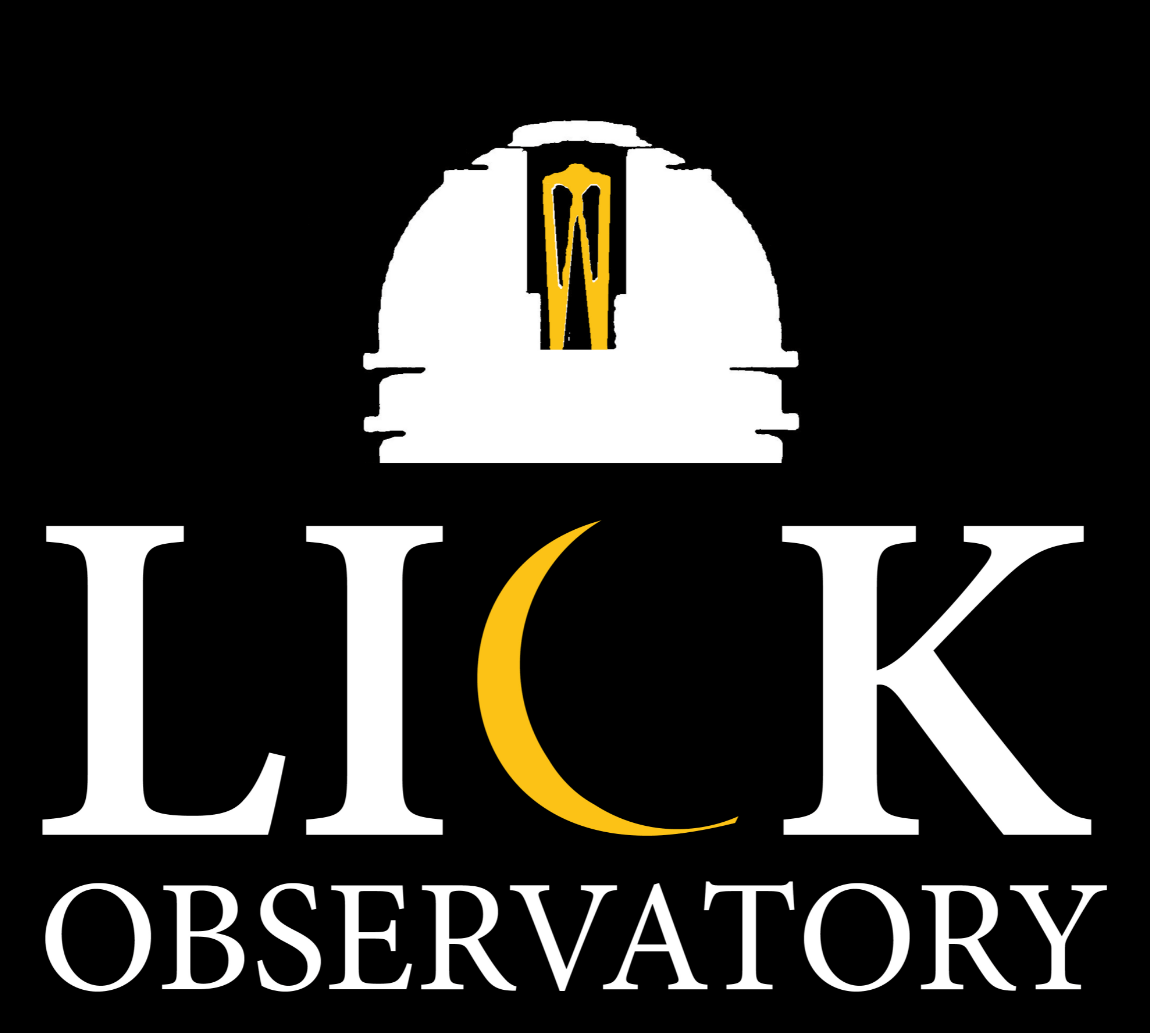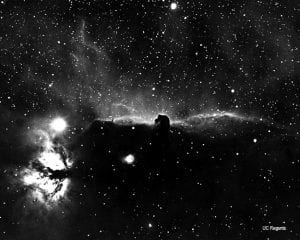Carnegie Double Astrograph
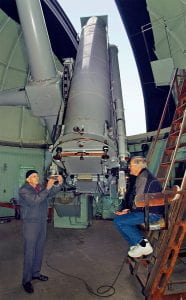
The 20-inch Double Astrograph is a unique wide-angle photographic camera, specially designed for the historic Lick Northern Proper Motion survey, a mammoth photographic survey of the northern sky carried out over half a century by four generations of Lick astronomers. The Astrograph was designed and built during the Great Depression, with funds granted by the Carnegie Corporation in 1934. It was installed, at first with the “blue” lens only at Mount Hamilton in 1941, and completed with the addition of the “yellow” lens in 1962, funded by the National Science Foundation.
A double astrograph is the optimal telescope to survey large areas of the sky accurately and efficiently. The two 20-inch refractors are mounted side-by-side, like a pair of binoculars. Each telescope views the same 6 x 6 degree field (about 1/1000 of the whole sky, or 75 times the field of Lick’s 36-inch refractor), and records the image on a huge 17 x 17 inch photographic plate. (Notice the large plate holders at the bottom of the telescope in the Astrograph photo at right.) Each sky field can be simultaneously photographed in two colors (blue and yellow), because the two refractors are designed to focus blue or yellow light, and use blue- or yellow-sensitive (black-and-white) photographic plates, respectively. Two-color observations let astronomers measure the color, as well as the brightness (magnitude), of each star on the plates. Colors tell the stars’ temperatures; hot stars are blue, and cool stars are red. Colors and magnitudes together help astronomers determine stellar distances.
Astrographic refractors not only provide a wide field of view; they also have an optical design that projects the sky accurately onto the flat photographic plates. This lets astronomers accurately measure the stars’ positions on the sky by measuring the location of their images on the plates. If the same sky field is photographed twice, decades apart in time, nearby stars’ motions on the sky (called “proper motions”) can be measured against the background of distant stars, or better yet, against the motionless background of distant galaxies. Lick’s 20-inch Double Astrograph was designed to be large enough to photograph thousands of faint galaxies to create a reference frame by which to measure the proper motions of stars in our own Milky Way Galaxy.
Before 1920, as astronomers began to understand that the so-called “spiral nebulae” were actually distant galaxies, far outside the Milky Way, Lick Observatory astronomer W.H. Wright tested their use as reference objects. Wright showed that a large, wide-field astrograph would be necessary for a proper motion survey using faint galaxies. When advances in optical design made such a telescope possible, Wright oversaw the acquisition of the 20-inch Astrograph, which saw “first light” in 1941. World War II delayed plans for the second lens. C.D. Shane took over the program in 1945 after Wright retired, and decided to start first-epoch photography with the blue lens alone.

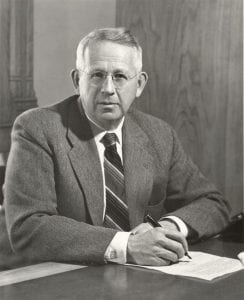
Shane-Wirtanen Galaxy Counts
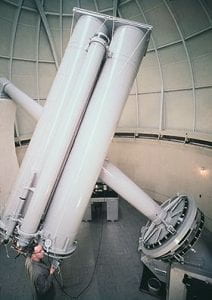
Between 1947 and 1957, Shane and C.A. Wirtanen (pictured in photo on right) photographed the northern 3/4 of the sky, taking first-epoch plates for 1,390 fields from the North Celestial Pole down to 33 degrees south declination. (This is all of the sky usefully visible from Mount Hamilton. The far southern sky was eventually photographed by Yale University astronomers working in South America.)
Shane expected that 50 years would have to pass before the stars would have moved enough to warrant taking second-epoch photographs for the proper motion survey. Meanwhile, the Lick plates could be used for a pioneering project in observational cosmology: mapping the distribution of galaxies on the sky.
Between 1948 and 1959, Shane and Wirtanen identified and counted nearly one million faint, distant galaxies on the Lick plates. Sky maps and statistical analysis, published in 1967, revealed a remarkable discovery: Galaxies clump and cluster into great networks and filaments, with comparatively empty space in between. As the first large, wide-angle galaxy survey, the Shane-Wirtanen galaxy counts became the fundamental database for a whole generation of cosmological research.
Lick Northern Proper Motion Program
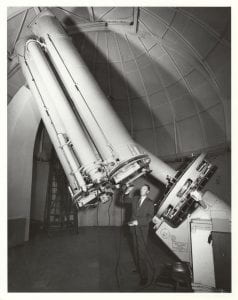
S. Vasilevskis took charge of the Lick Northern Proper Motion (NPM) program in 1954, at the dawn of the computer age. Vasilevskis realized that the project could be completed much more quickly by taking advantage of modern technology, such as automated plate measurement and computerized data reduction. Vasilevskis pioneered the design and construction of an automatic measuring machine that quickly and accurately measured star positions and photometry (intensity of light). After the yellow lens was installed in 1962, completing the Double Astrograph, Vasilevskis and A.R. Klemola photographed and measured 100 fields and showed that the Lick program could proceed after only 25 years between epochs, not 50.
Second-epoch photography for the NPM program began in 1969. The last of the 2,492 plates (for 1,246 fields down to 23 degrees south) was taken in 1988, 41 years after the first-epoch photography began. An average field has a span of 27 years between first and second epochs.
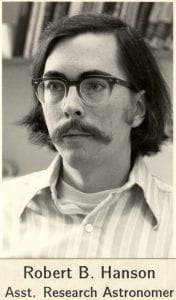
B.F. Jones took over the NPM program in 1979. Klemola and Jones took most of the second-epoch plates, and R.B. Hanson was responsible for most of the data reductions. A new generation of technology made it possible to scan the photographic plates, detecting and measuring all the stars and galaxies on each plate. Between 1996 and 1999, we shipped 3,882 Lick plates to Flagstaff, Arizona, where they were scanned at the US Naval Observatory. The plates were returned along with 207 CD-ROMs of data for 3 billion images detected on the plate scans.
The main goals of the Lick NPM program were to establish a motionless reference frame of distant galaxies and to measure the motions of stars in our own Galaxy. This divided the NPM program in two distinct phases. “NPM1” covered 899 astrograph fields away from the plane of the Milky Way. “NPM2” covered the remaining 347 fields near the Galactic plane, where reference galaxies are absent. Two large catalogs of stellar data were produced. The 1993 Lick NPM1 Catalog contains 148,940 stars, whose proper motions were measured in a reference frame defined by 50,517 faint galaxies. The 2003 Lick NPM2 Catalog contains 232,062 stars, with proper motions measured in a reference frame defined by the European Space Agency’s “Hipparcos” satellite project.
The two Lick NPM catalogs, with accurate positions, proper motions, magnitudes, and colors for some 380,000 stars, reside electronically at the CDS stellar data center at Strasbourg, France where astronomers around the world can use the NPM data for research projects in Galactic structure and stellar motions.
Lick astronomers have used the NPM1 and NPM2 data to study and measure four systematic patterns in the motion of our Milky Way Galaxy:
- Our galaxy’s rotation causes a small, complex pattern of stellar motions over the entire sky.
- Like the sun, about 95% of our galaxy’s stars belong to the “Thin Disk” population, following a roughly circular pattern near the Galactic Plane. The average velocity of these stars (including the sun) is about 20 km/s faster than the rotation of the Galaxy.
- About 5% of our galaxy’s stars belong to the “Thick Disk,” an older population of stars not as concentrated to the Galactic Plane. The average velocity of these stars is about 50km/s slower than the circular Galactic rotation.
- About one star in two hundred (0.5%) belongs to the Galaxy’s very old “Halo” population, a non-rotating relic of the era when the Milky Way Galaxy formed some 12 billion years ago.
For technical information on the Lick Northern Proper Motion program, please visit the NPM web page, or read the 2004 Astronomical Journal paper, which reports the completion of the NPM program and acknowledges the long list of people who contributed to its success. The NPM program particularly thanks the National Science Foundation for its long-term support.
The Astrograph Today
The Carnegie Double Astrograph has finished its historic sky survey and is officially retired. However, the dome that houses the Astrograph telescope is not retired. In late 2019 the PANOSETI instrument was installed, to search for laser signals from intelligent extraterrestrial life.
